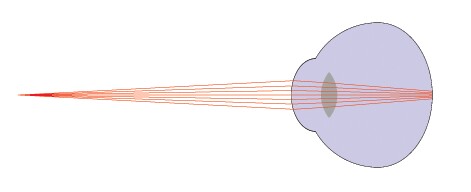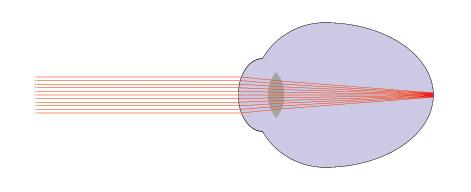Vision Problems
Near
Sightedness or Myopia
Commonly known as
near-sightedness, myopia is a condition where the eye cannot focus on
images at far distances. Most often, this problem is caused by the back
of eye being too long, and hence the images that people see are out of
focus. As mentioned previously, the eye see objects from infinity at
"rest", and sees objects closer by adjusting the lens so that image
focuses at the back of eye. For near-sighted people, the elongation of
their eye results in light coming in from infinity (or far distances) to
become out of focus, no matter how the lens adjusts. This results in
distance objects looking blurry.
Despite the extension
of the eye, the lens is still able to focus so that objects closer can
be seen. The lens stretches out, and reduces the focal length of light,
which allows it to hit the back of the eye.
Far-Sightedness
or Hyperopia
Hyperopia occurs when
the back of the eye is closer than is should be. In this case, the
individual can see objects from far distances, but cannot see objects
from short distances. When light from infinity hits the far-sighted eye,
is doesn't focus. However, the eye can compensate by adjusting its lens
and shortening the focal length. This allows a focused image to be cast
on the back of the eye.
However, because the lens only has limited strength, it can only adjust
the lens so far, and cannot focus on objects that are up close. This
causes images that are closer to remain out of focus, and the diagram
shows.

Spherical lens can be used to correct our vision by "enhancing" our own
natural vision. You can read more about that in the next section.
